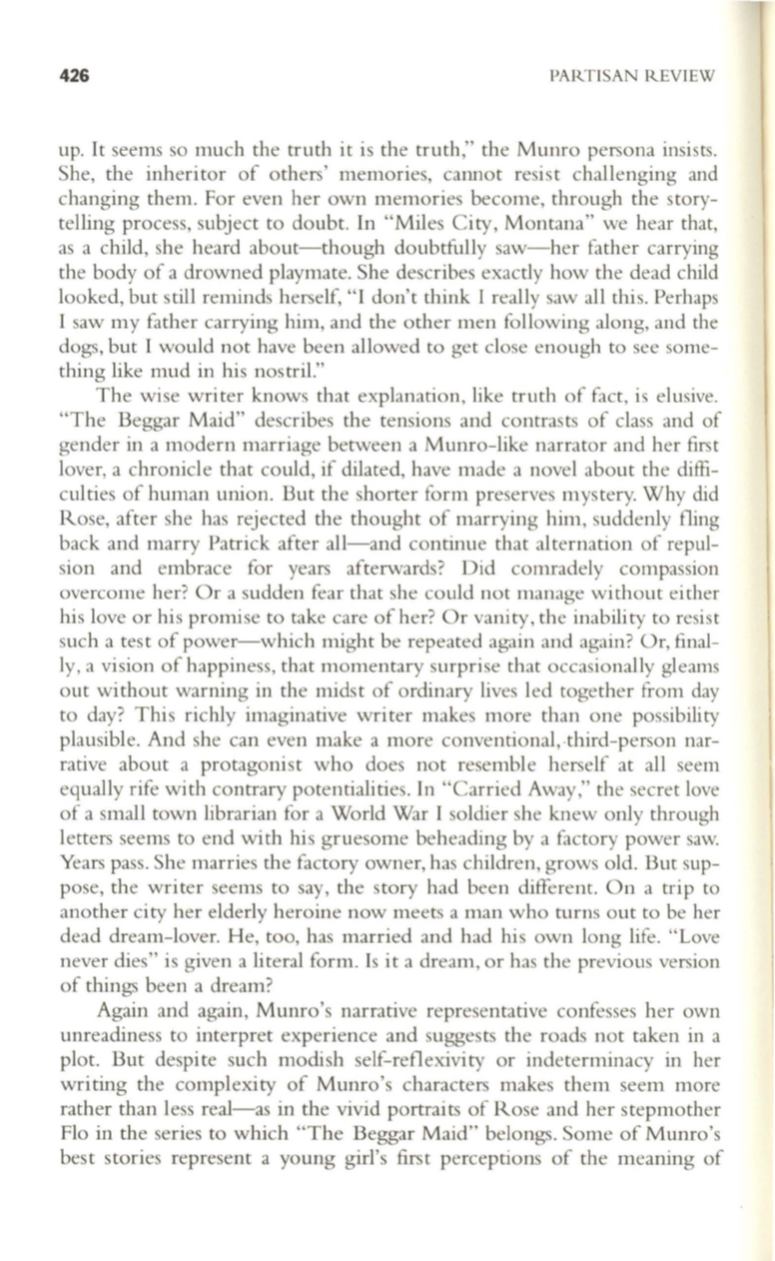
426
PARTISAN REVIEW
up. It seems so much the truth it is the truth ," the Munro persona insists.
She, the inheritor of others' memories, cannot resist challenging and
changing them. For even her own memories become, through the story–
telling process, subject to doubt. In "Miles City, Montana" we hear that,
as a child, she heard about-though doubtfully saw-her father carrying
the body of a drowned playmate. She describes exactly how the dead child
looked, but still reminds herself, "I don't think I really sawall this. Perhaps
I saw my father carrying him, and the other men following along, and the
dogs, but I would not have been allowed to get close enough to see some–
thing like mud in his nostril."
The wise writer knows that explanation, like truth of fact, is elusive.
"The Beggar Maid" describes the tensions and contrasts of class and of
gender in a modern marriage between a Munro-like narrator and her first
lover, a chronicle that could, if dilated, have made a novel about the diffi–
culties of human union. But the shorter form preserves mystery. Why did
Rose, after she has rejected the thought of marrying him, suddenly fling
back and marry Patrick after all-and continue that alternation of repul–
sion and embrace for years afterwards? Did comradely compassion
overcome her? Or a sudden fear that she could not manage without either
his love or his promise to take care of her? Or vanity, the inabili ty to resist
such a test of power-which might be repeated again and again? Or, final–
ly, a vision of happiness, that momentary surprise that occasionally gleams
out without warning in the midst of ordinary lives led together from day
to day? This richly imaginative writer makes more than one possibility
plausible. And she can even make a more conventional, .third-person nar–
rative about a protagonist who does not resemble herself at all seem
equally rife with contrary potentialities. In "Carried Away," the secret love
of a small town librarian for a World War I soldier she knew only through
letters seems to end with his gruesome beheading by a factory power saw.
Years pass. She marries the factory owner, has children, grows old. But sup–
pose, the writer seems to say, the story had been different. On a trip to
another city her elderly heroine now meets a man who turns out to be her
dead dream-lover. He, too, has married and had his own long life. "Love
never dies" is given a literal form. Is it a dream, or has the previous version
of things been a dream?
Again and again, Munro's narrative representative confesses her own
unreadiness to interpret experience and suggests the roads not taken in a
plot. But despite such modish self-reflexivity or indeterminacy in her
writing the complexity of Munro's characters makes them seem more
rather than less real-as in the vivid portraits of Rose and her stepmother
Flo in the series to which "The Beggar Maid" belongs. Some of Munro's
best stories represent a young girl's first perceptions of the meaning of


